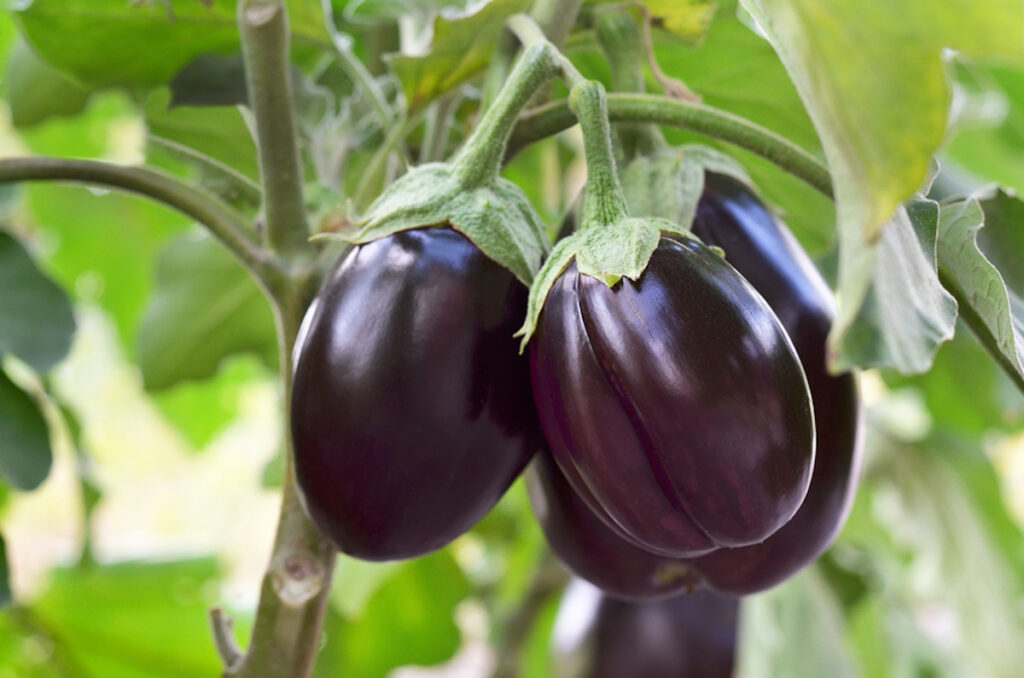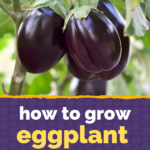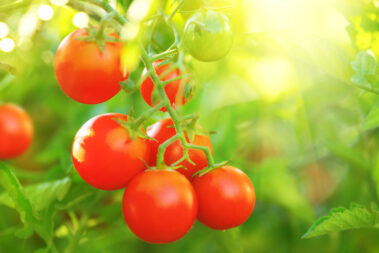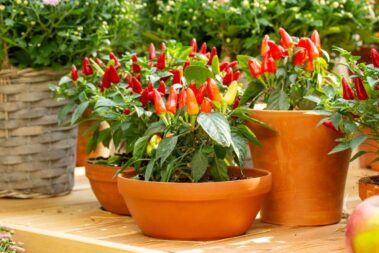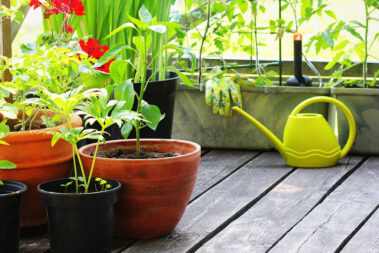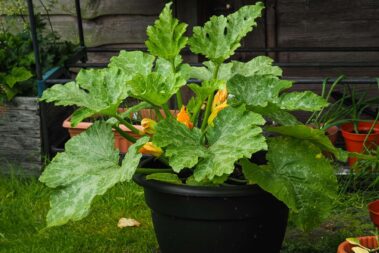With large violet flowers and fruits that come in a variety of different shapes from round to oblong and different colors from deep purple to white, growing eggplant may be even more fun than eating it.
Luckily, growing this beautiful fruit isn’t just reserved for those with large garden plots. In fact, many varieties of this heat-loving nightshade often grow better in containers than they do in the ground.
By following our quick tips below, even the most novice gardener can grow exquisite eggplant on their patio or deck.
Table of Contents
The Best Mini Eggplant Varieties to Grow
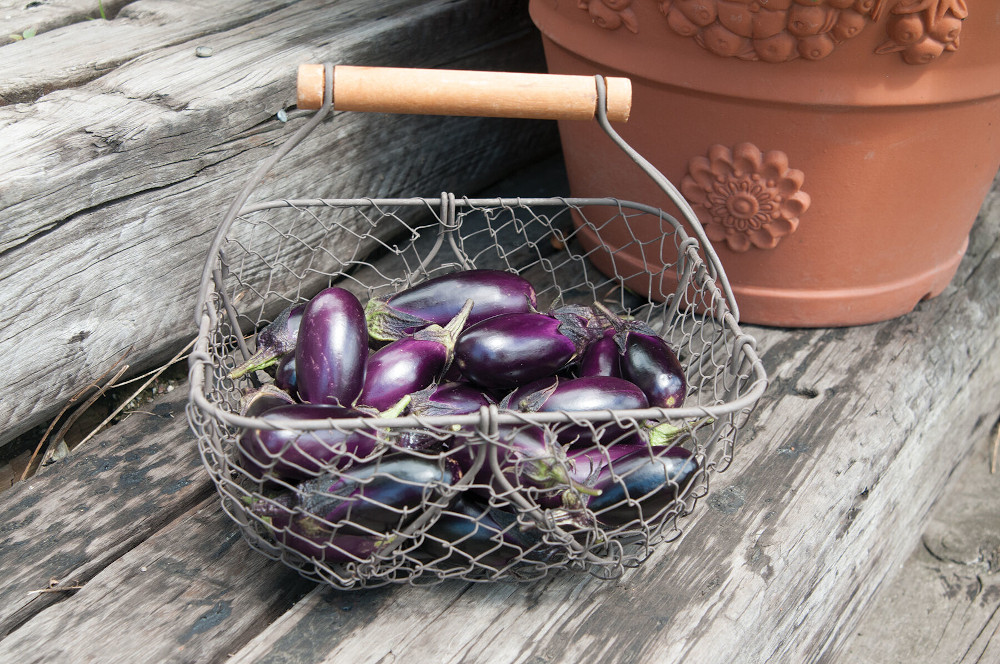
While it is possible to grow just about any eggplant variety in a container assuming you have the space and time to care for it, there are certain varieties that are easier to grow in cramped spaces than others.
Here are a few of our favorite eggplant varieties for planting in pots:
- Patio Baby – The name says it all with this little purple beauty. This plant is compact and produces fruit no larger than three inches.
- Hansel – This compact plant produces slightly larger deep purple fruit at about four inches long when ripe. This variety is easy to care for in containers and keeps a smaller shape while producing abundantly.
- Gretel – This plant is very similar to the Hansel variety in size and abundance of fruit but produces beautiful solid-white eggplants that you have to see to believe.
- Fairy Tale – This plant tends to be even smaller than the Hansel and Gretel types while producing similar sized fruit. But what really sets this variety apart is the whimsical purple and white striped eggplants it puts out.
How to Grow Eggplants in Containers
Once you have your variety (or varieties) picked out, its time to get planting. Follow the steps below to cultivate gorgeous plants to brighten up your patio and your plate all summer long.
1. Pick Your Pots
Compact eggplant varieties don’t need a ton of room to grow, and many of the smaller types will do just fine in pots as small as two gallons. But, keep in mind, the larger the pot, the less frequently you will need to water. The most important factor for any pot is drainage, so make sure your pot has plenty of holes in the bottom and don’t be afraid to drill out a few more if needed.
2. Choose Your Soil
Eggplants like well-draining soil but over-dryness can affect the overall look and taste of the fruit. Most standard potting soils will work fine, but those made to hold more moisture may need to be mixed with a little mulch to promote better drainage. Adding mulch or straw to the top of the soil will help prolong the time between needed waterings. Mixing in some all-purpose fertilizer in with your soil before planting will get your seedlings started out on the right track.
3. Plant Your Eggplants
It’s easiest to buy seedlings from your local garden center, but varieties will be limited. If you would rather go the route of starting your plants from seeds, do so inside about eight to ten weeks before the last frost date for cooler climates. The benefit of growing your plants in containers is that you can direct seed into the pots and keep them indoors during cooler weather and move them outside permanently in the late spring. This will avoid any issues with transplant shock.
4. Find a Sunny Spot
Eggplants, like tomatoes and peppers, are from the nightshade family and prefer warm soil and air. Container gardening makes achieving the first of those needs easy since the soil in pots, especially black pots, warms up quicker than soil in the ground. Keeping your plants in a sunny location (one that gets more than six hours of light a day) and moving them inside on cool nights will help them grow faster and stronger.
5. Fertilize and Water
All potted plants require frequent watering due to the limited volume of soil used. Eggplants can be tougher than most because they really don’t like to be over-moist or too dry. Check your containers at least twice a day and water well when the top layer of soil begins to dry. Having plenty of drainage holes in your pot should allow the water to run through quickly while still bringing much-needed moisture.
Eggplants are also heavy feeders and require a lot of nutrients to keep them producing consistently. Use a diluted liquid fertilizer about every two weeks once the plants reach a few inches tall. Once they start to fruit, frequent fertilization will become even more important.
6. Harvest!
While some varieties mature rather quickly and start putting out fruit in as little as two months others take over three months before you’ll get to enjoy the fruits of your labor. Check your seed packet or plant description to know about when your eggplants will begin to flower and at what size you should pick your fruit.
Most eggplants will develop a sheen on their skin as they ripen and will give just slightly when squeezed. Overripe fruit will be seedy and bitter while underripe fruit will be hard.
Common Problems You May Run Into
One of the biggest advantages of container gardening is you don’t have to deal with as many pests. And when you do, it is generally easier to get rid of them than when you are working with an immobile garden. The same is true of nutrient issues; Having a very concentrated ecosystem usually means its easy to make nutrient adjustments.
Of course, to be able to fix these problems, you still need to know how to identify them. Here are some of the more common problems you will run into when growing eggplant:
- Blossom End Rot – This common nightshade affliction causes the blossom end of the eggplant to brown and become squishy as the fruit grows. This is caused by poor calcium absorption by the plant due to infertile soil or, more likely, uneven watering. To prevent or reduce this condition, mix crushed eggshells or calcium supplements into your soil and try to avoid letting the soil become too dry while also avoiding overwatering.
- Flea Beetles – These are a common eggplant pest, but, luckily, are less likely to affect potted veggies. If you do notice the telltale tiny holes in your eggplant leaves, try moving the pots further from other garden beds or open dirt. You can also try dusting your plants with talcum powder or setting sticky traps in the soil to catch beetles as they move around.
Despite the occasional challenge that may pop up when trying to grow eggplants, these nightshades are still one of the easiest veggies to grow in pots. And they are certainly one of the most beautiful!
- How to Pick the Perfect Watermelon For a Sweet Summer Treat - April 10, 2024
- Future Kind’s Foundations: A Multivitamin Made for Vegans - December 5, 2023
- Does Nutritional Yeast Go Bad? - November 28, 2023

